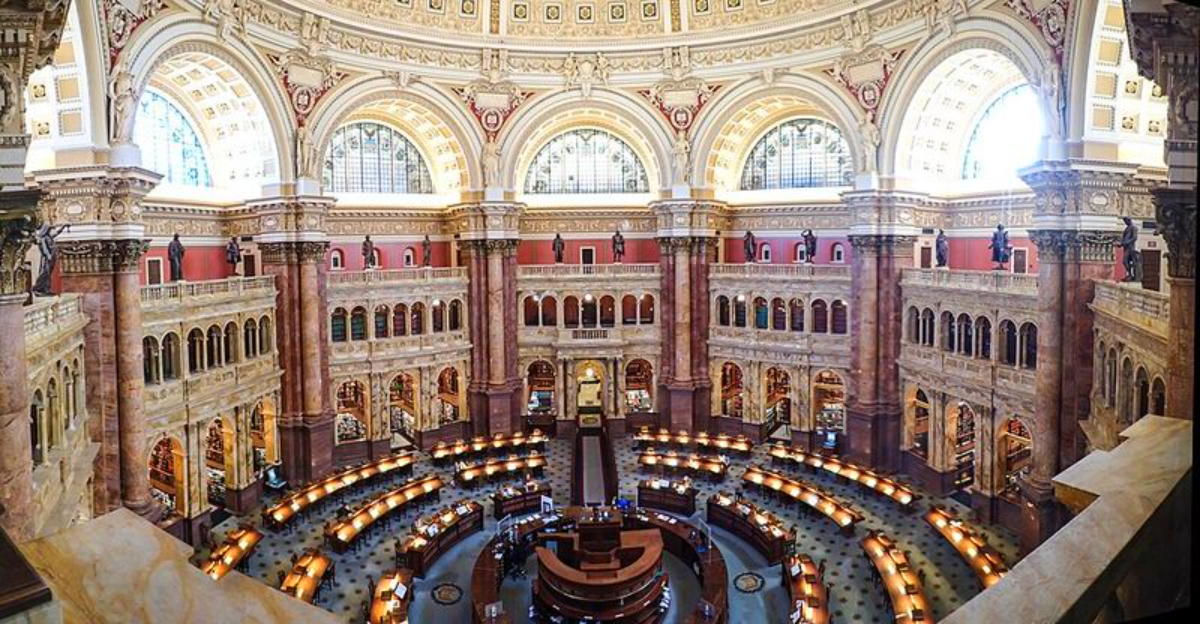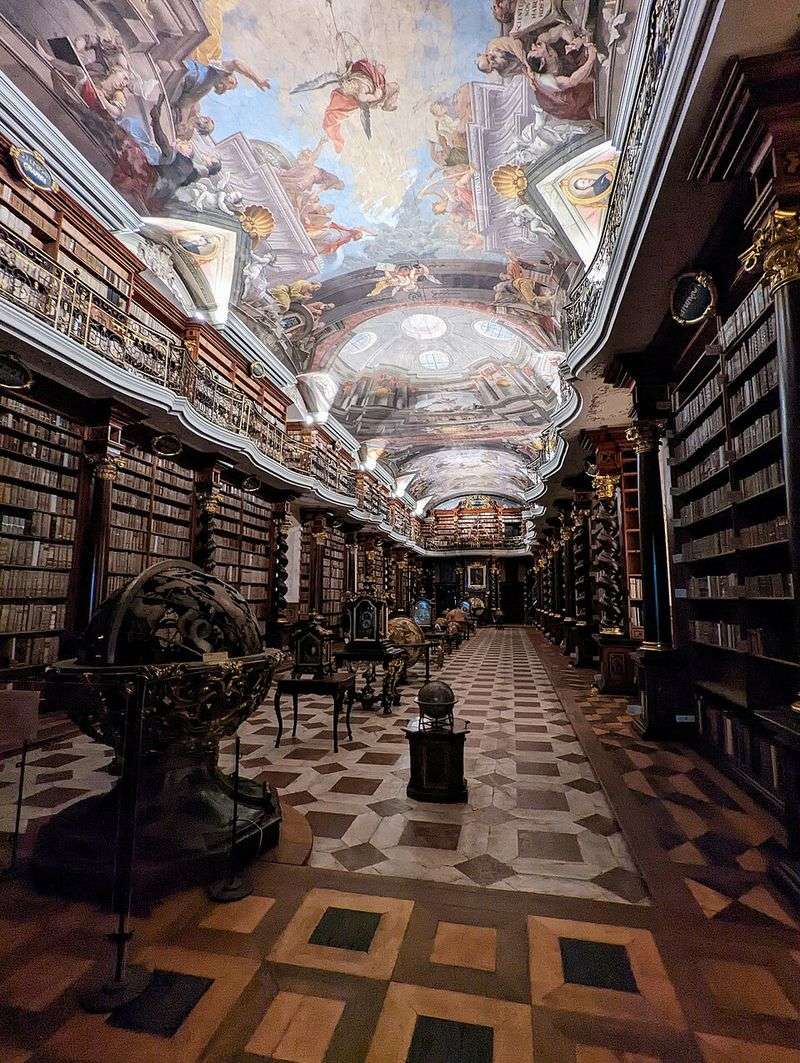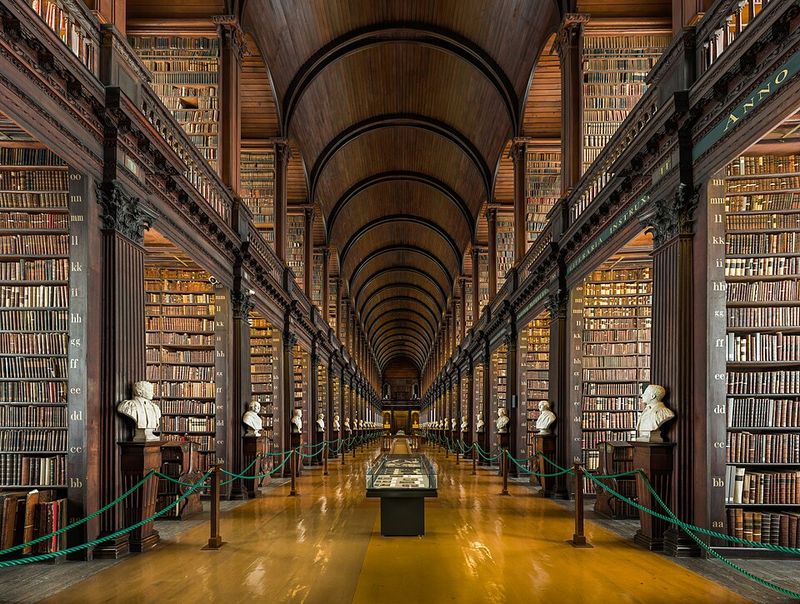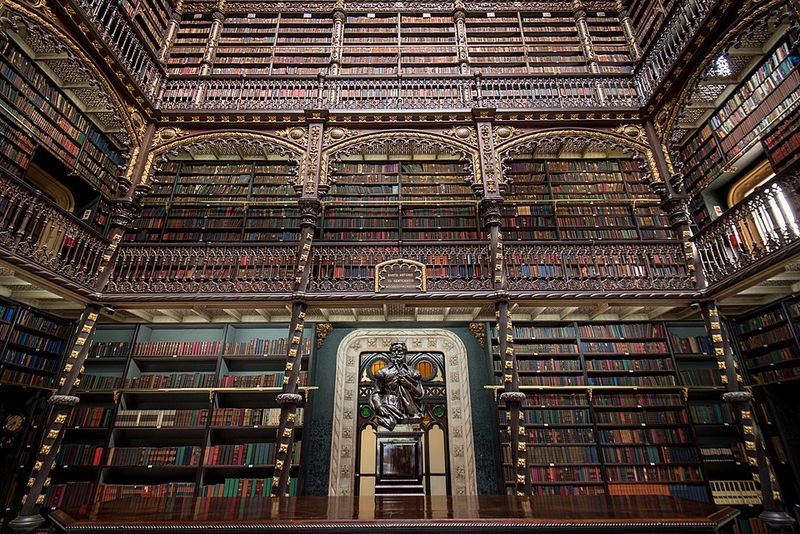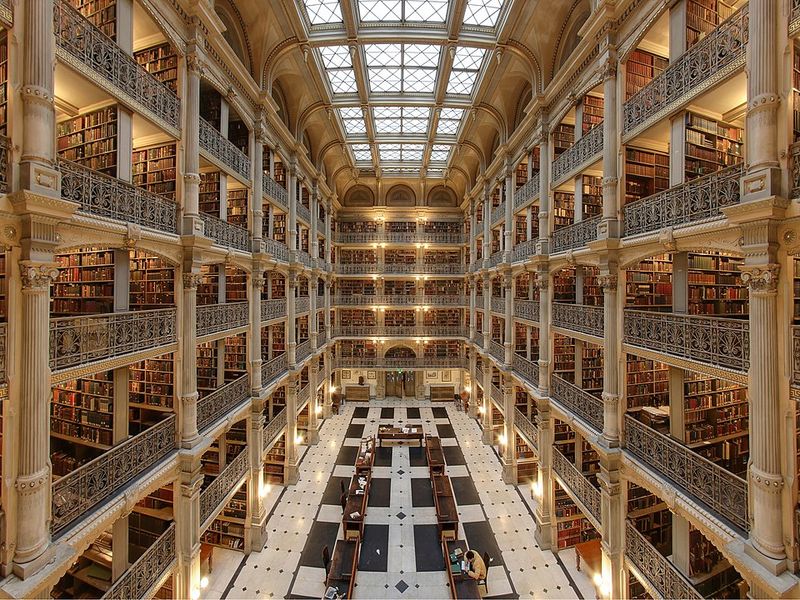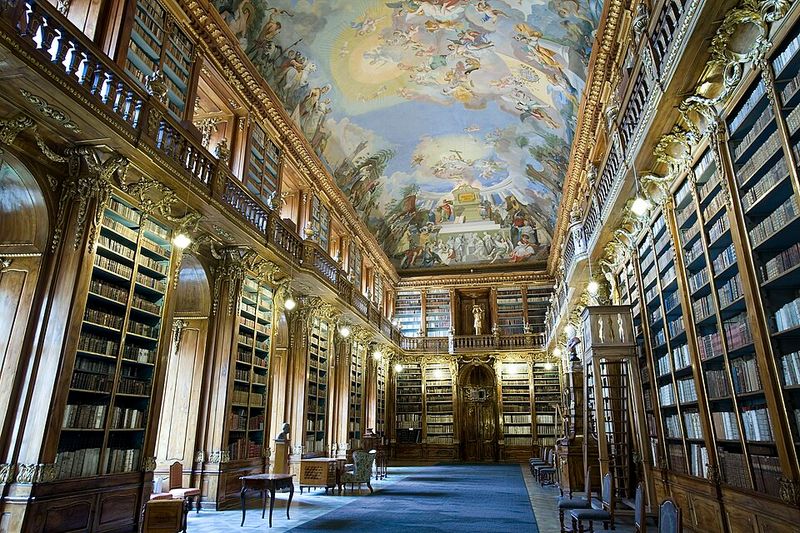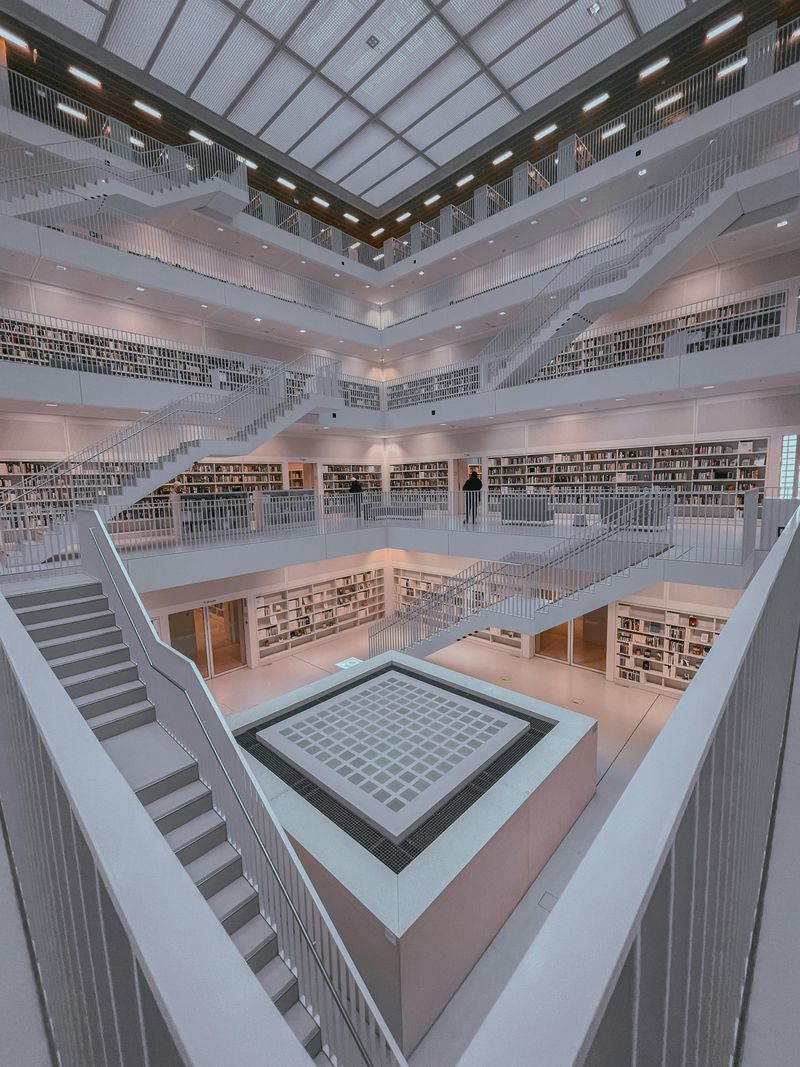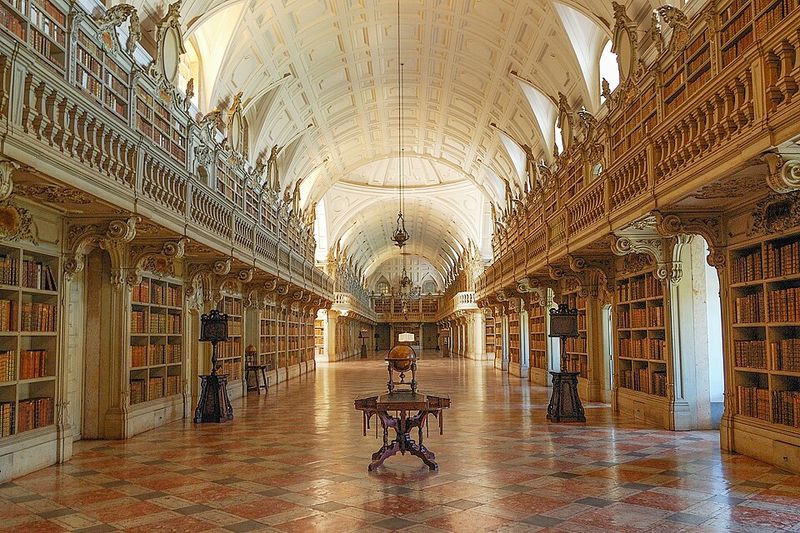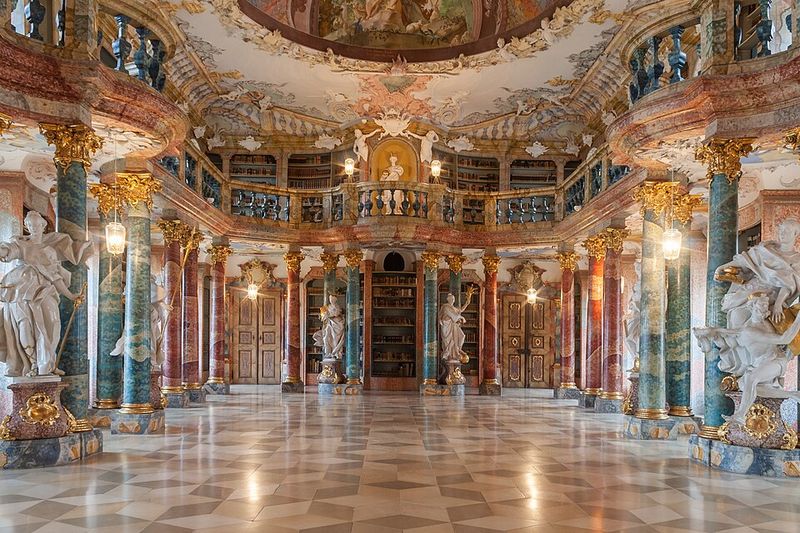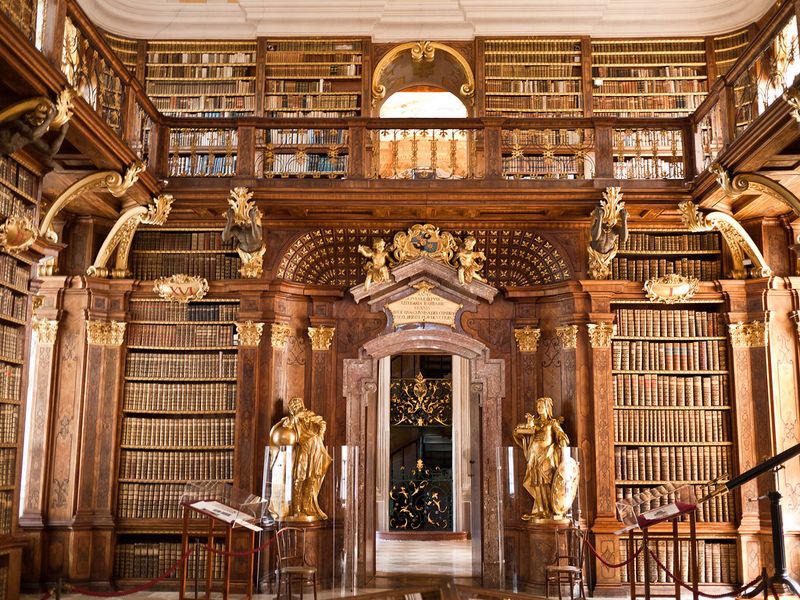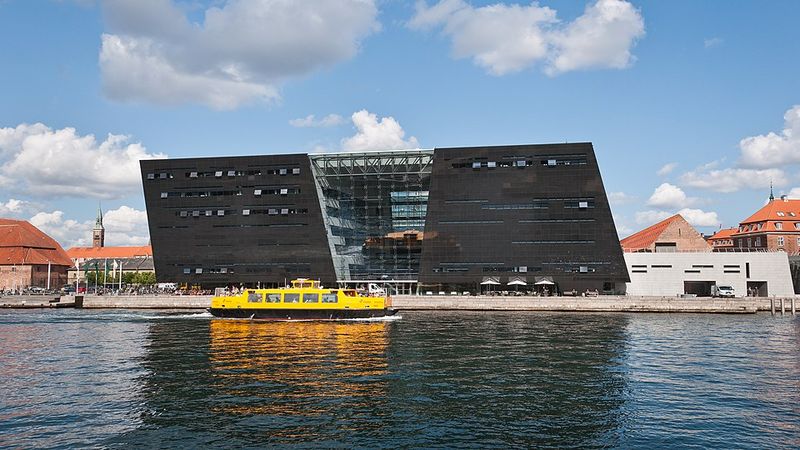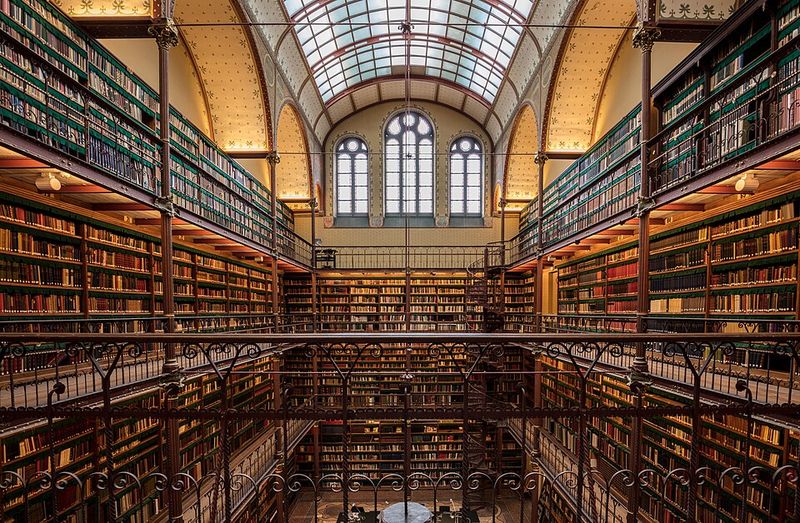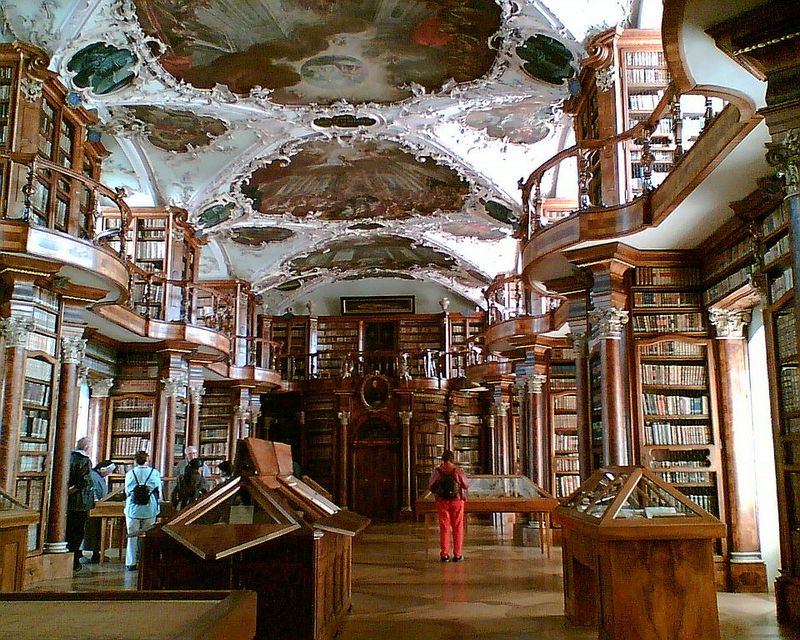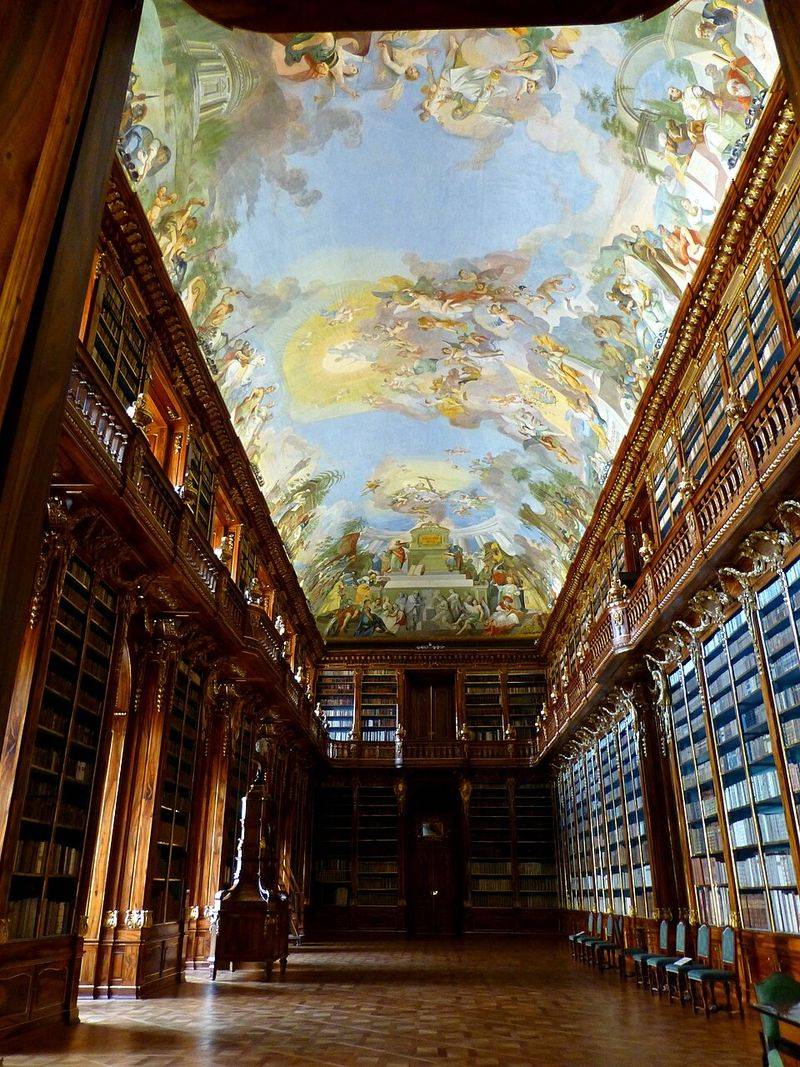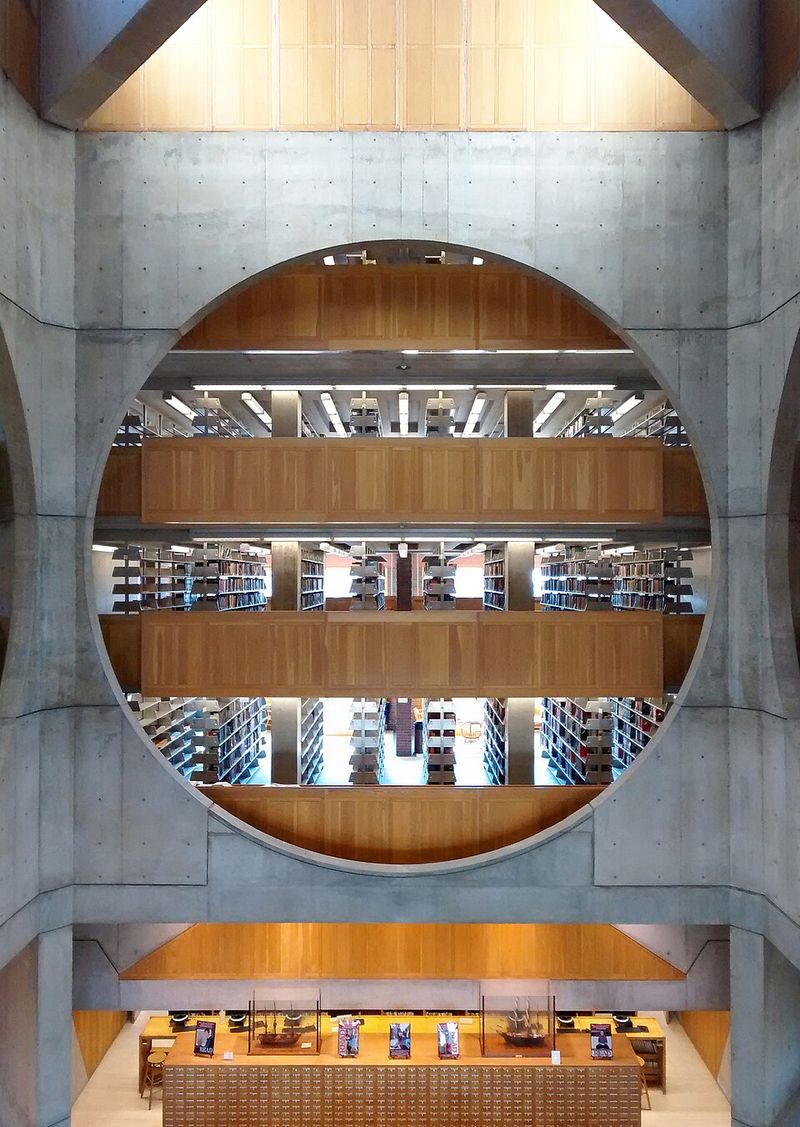From gilded Baroque halls to minimalist cubes of glass and light, the world’s most beautiful libraries are temples to human curiosity. These spaces don’t just store books—they stage wonder, invite reflection, and celebrate centuries of art and intellect. Journey from Prague’s frescoed vaults to Paris’s iron-and-air elegance to discover places where architecture elevates reading into ritual. Ready to step into rooms that make knowledge feel sacred?
Klementinum Library – Prague, Czech Republic
Often described as one of the most beautiful libraries in the world, the Klementinum Library is a Baroque masterpiece dating back to 1722. Its soaring ceilings, frescoes by Jan Hiebl, and rows of antique globes create an atmosphere of awe. Once part of a Jesuit college, it now houses over 20,000 rare volumes, including early scientific texts. The warm wood tones and golden light filtering through tall windows make visitors feel as though they’ve stepped into a cathedral of knowledge. Every inch of the library embodies centuries of Czech scholarship and artistry. Step into the long nave-like hall, and you’ll feel history breathing from every carved shelf and gilded flourish—an immersive backdrop where time seems to pause and reverence for learning deepens with each careful footfall.
Sainte-Geneviève Library – Paris, France
Located across from the Panthéon, this 19th-century library is an architectural marvel of iron and light. Designed by Henri Labrouste, its open, vaulted reading room was revolutionary for its time—airy, elegant, and lined with endless shelves of wisdom. The library’s cast-iron arches and natural illumination give it a sense of calm grandeur. Home to more than two million documents, it’s a favorite haunt for students and dreamers alike. Sainte-Geneviève perfectly captures Paris’s blend of beauty, intellect, and timeless inspiration. Sit beneath its rhythmic arches and the city’s intellectual heartbeat becomes audible: page turns, hushed footsteps, and distant bells from the Panthéon. Here, modern scholarship converses with industrial grace, proving that iron can be as poetic as stone when it frames the pursuit of knowledge.
Trinity College Library – Dublin, Ireland
The Long Room at Trinity College is one of the most iconic library spaces in the world. Built in the early 18th century, it stretches nearly 65 meters, filled with dark oak shelves and over 200,000 of Ireland’s oldest books. Marble busts of philosophers and writers line the central aisle, watching over visitors in silent grandeur. The library also houses the legendary Book of Kells, an illuminated manuscript dating to the 9th century. Walking through the Long Room feels like stepping into a living monument of Irish culture and knowledge. The scent of polished wood and parchment creates an atmosphere of reverence, while the soft light reveals gilded titles whispering forgotten histories. Every step resounds with the cadence of scholarship, making the space feel hallowed yet human.
The Royal Portuguese Reading Room – Rio de Janeiro, Brazil
Hidden in the heart of Rio, this neo-Manueline treasure looks like something from a dream. Opened in 1887 by Portuguese immigrants, it features ornate woodwork, a stained-glass dome, and more than 350,000 volumes. The sunlight that pours through the ceiling illuminates the richly carved balconies and the colorful spines of old books, creating a kaleidoscope of culture. The library is not just beautiful—it’s a celebration of Portuguese heritage and the power of literature to bridge continents. Each glance reveals filigreed details and maritime motifs that evoke voyages and discoveries. Stand beneath the glowing dome, and you’ll feel history radiate like tropical light, turning reading into a ceremonial act. It’s a sanctuary where page and place conspire to make memory luminous.
Admont Abbey Library – Admont, Austria
Set within a Benedictine monastery, the Admont Abbey Library is a vision of enlightenment. Completed in 1776, it’s the largest monastic library in the world, containing over 70,000 volumes. The white and gold interior, adorned with pastel frescoes by Bartolomeo Altomonte, creates an ethereal glow. Sculptures representing the stages of human knowledge stand between the shelves. It’s a space that fuses art, philosophy, and faith—proof that beauty and learning have always gone hand in hand. As light drifts across gilded capitals and marble floors, the room seems to breathe with serenity. Every corner is a dialogue between reason and reverence, inviting contemplation. Visitors leave with a renewed sense that wisdom is not merely stored here—it is performed in color, form, and silence.
George Peabody Library – Baltimore, USA
Nicknamed the “Cathedral of Books,” the George Peabody Library is one of America’s most breathtaking architectural gems. Opened in 1878, its five-tiered atrium features cast-iron balconies, marble floors, and a skylight that floods the room with natural light. The library’s 300,000 volumes—many dating to the 18th century—seem to float in midair. Beyond its scholarly role, the library is a popular wedding venue, and for good reason: few places blend romance and intellect so seamlessly. The intricate ironwork frames shelves like lacework, heightening the sense of drama. Standing on the marble below, you feel suspended between centuries, invited to look up and imagine. It’s a place where the architecture flirts with the light, and scholarship finds its most photogenic stage.
Strahov Monastery Library – Prague, Czech Republic
Another of Prague’s treasures, the Strahov Monastery Library dates back to the 17th century and is divided into two magnificent halls—the Theological and the Philosophical. Each is adorned with elaborate frescoes, gilded stucco, and antique globes. The ceilings depict themes of divine wisdom and human pursuit of knowledge, embodying centuries of monastic devotion to learning. Visitors must remain behind velvet ropes, but even from a distance, the artistry and serenity of Strahov are overwhelming—a true sanctuary of scholarship. The scent of waxed wood and faint incense lingers in the air, enhancing the contemplative mood. Light skims across globes and gilding, revealing craftsmanship that rewards slow looking. It’s the kind of beauty that hushes footsteps and invites inwardness.
The Library of Congress – Washington, D.C., USA
As the largest library in the world, the Library of Congress is as monumental as the nation it serves. Its Jefferson Building, completed in 1897, features marble columns, mosaics, and frescoes that rival any palace. The Main Reading Room, crowned by a massive dome, feels both majestic and democratic—a temple of learning open to all. Housing more than 170 million items, it represents the heart of American intellectual and cultural heritage. Visiting it is both humbling and inspiring. The colored marbles, classical iconography, and radiating desks form an orchestration of civic pride. Sit under the dome and feel the hum of inquiry: researchers, citizens, and dreamers sharing the same luminous circle of light.
Stuttgart City Library – Stuttgart, Germany
Sleek, modern, and almost otherworldly, the Stuttgart City Library is a striking contrast to Europe’s historic reading halls. Designed by Korean architect Eun Young Yi and completed in 2011, it’s a cube-shaped structure glowing with minimalist beauty. Inside, an all-white atrium ascends around a central void, where books bring bursts of color against the monochrome background. The symmetry and silence create an atmosphere that feels futuristic yet peaceful—a true cathedral of modern design and knowledge. Light falls evenly across terraces, making every step feel intentional. The architecture encourages roaming and discovery, as if knowledge were a landscape. Here, clarity is the luxury: empty space that lets ideas resonate.
Bodleian Library – Oxford, England
One of the oldest libraries in Europe, the Bodleian has been a sanctuary of scholarship since 1602. Its Gothic halls, vaulted ceilings, and ancient manuscripts give it a gravitas few libraries can match. Students of Oxford still take oaths to respect its books, maintaining a centuries-old tradition. The Radcliffe Camera, one of its reading rooms, is a masterpiece of neoclassical architecture and a symbol of learning worldwide. To wander through the Bodleian is to feel the weight—and wonder—of history itself. The quiet echo of footsteps on stone seems to recite Latin mottos. Between carved bosses and leather spines, intellect becomes tangible, almost ceremonial.
Mafra Palace Library – Mafra, Portugal
Within the vast Mafra National Palace lies a Baroque library of staggering beauty. Stretching nearly 90 meters long, it houses over 36,000 leather-bound volumes in soaring wooden bookcases. The polished marble floors and gilded details glow under natural light from arched windows. Uniquely, the library is protected by resident bats, which feast on insects to preserve the books. It’s a perfect marriage of elegance, intellect, and nature—an enchanting secret within Portugal’s royal heritage. The long perspective draws the eye toward a vanishing point of learning, while faint scent of wax and vellum lingers. Mafra feels like a grand corridor where centuries converse in whispers.
Joanina Library – Coimbra, Portugal
Part of the University of Coimbra, the Joanina Library is an opulent 18th-century treasure. Its gilded woodwork, frescoed ceilings, and carved bookcases create a regal atmosphere befitting one of Europe’s oldest universities. Over 60,000 volumes are preserved here, including rare manuscripts and early scientific works. Like Mafra, it’s home to a colony of bats that protect the books from pests. Every detail—down to the ornate chandeliers—reflects Portugal’s golden age of exploration and learning. The interplay of dark lacquer, gold leaf, and painted allegories conjures a theatrical stage for scholarship. Visitors sense a hush that feels ceremonial, as though entering a court where knowledge is sovereign.
The Royal Library of El Escorial – Madrid, Spain
Commissioned by King Philip II in the 16th century, this library inside the Escorial Monastery symbolizes the union of faith and reason. Its frescoed ceilings depict the seven liberal arts, while walnut shelves hold over 40,000 volumes, including illuminated manuscripts and Arabic texts. Light pours through tall windows, illuminating the gleam of gilded spines. The Royal Library stands as a monument to Spain’s intellectual zenith—a place where art and wisdom coexist in perfect harmony. The solemn rhythm of the room invites slow reading and slower breathing. Between celestial allegories and dark wood, the Renaissance ideal still feels alive.
Wiblingen Abbey Library – Ulm, Germany
Wiblingen Abbey’s library is a rococo fantasy come to life. Completed in the 18th century, its white and pastel interior dazzles with marble columns, gilded statues, and allegorical frescoes. Above the doorway, an inscription reads “In quo omnes thesauri sapientiae et scientiae,” meaning “In which are all the treasures of wisdom and science.” The phrase perfectly encapsulates the library’s spirit: beauty as a vessel for enlightenment. Walking inside feels like entering a palace built for the mind. The playful curves, cloudlike ceilings, and theatrical colors make learning feel joyous. It’s a room that smiles, then teaches.
Melk Abbey Library – Melk, Austria
Overlooking the Danube River, Melk Abbey’s library is one of Europe’s Baroque masterpieces. Golden shelves, frescoed ceilings, and spiral staircases give it a divine glow. Home to thousands of medieval manuscripts, it was once a vital center of Benedictine learning. Even today, the scent of old parchment fills the air, reminding visitors that this is not just a museum but a living repository of knowledge. Melk embodies the timeless belief that wisdom is sacred. The interplay of light and gilding suggests a liturgy of reading, where each page turn feels like a small prayer. It’s intimate grandeur at its most enduring.
Austrian National Library – Vienna, Austria
Inside Vienna’s Hofburg Palace lies the Austrian National Library’s State Hall—a vision of imperial grandeur. Completed in the 18th century for Emperor Charles VI, it’s filled with marble statues, ceiling frescoes, and more than 200,000 ancient books. The room’s baroque symmetry and rich ornamentation convey both power and reverence. As sunlight filters through tall windows, the gilded details seem to shimmer. This library is not just a national archive—it’s a monument to the glory of learning. The cartographic globes and imperial crests underscore the reach of knowledge and empire. Standing here, you feel scholarship crowned and ceremonial, yet welcoming.
Royal Library of Copenhagen – Copenhagen, Denmark
Known as the “Black Diamond” for its gleaming modern façade, the Royal Library merges historic and contemporary design. The original 17th-century library is connected to a sleek, glass-fronted addition overlooking Copenhagen’s harbor. Inside, minimalist Scandinavian elegance meets the weight of history. With over 35 million items, including priceless manuscripts, it’s Denmark’s largest cultural institution. Its open, luminous spaces make it a haven for reflection—where the past and future of knowledge coexist beautifully. Glass bridges float above water-lit floors, and the city glimmers beyond. The building encourages movement and encounter, turning research into a public act of discovery.
Rijksmuseum Research Library – Amsterdam, Netherlands
Tucked within Amsterdam’s most famous museum, the Rijksmuseum Research Library is the largest art history library in the Netherlands—and one of the most photogenic. Its cast-iron staircases, arched ceilings, and rows of neatly aligned volumes create perfect symmetry. Visitors can watch researchers at work from an upper balcony, bathed in natural light from a towering skylight. Every detail reflects Dutch precision and devotion to art. It’s a quiet sanctuary where creativity and scholarship intertwine. The hush feels like a painter’s underlayer—supporting the brilliance to come. Here, references become revelations, and page margins feel as important as frames.
Bibliotheca Alexandrina – Alexandria, Egypt
A modern tribute to the ancient Library of Alexandria, this stunning structure was completed in 2002 and stands as a beacon of global knowledge. Its circular design symbolizes the rising sun of enlightenment, while granite walls are inscribed with scripts from over 100 languages. The vast reading room, capable of seating thousands, tilts toward the sea—linking past, present, and future. The Bibliotheca Alexandrina honors an ancient legacy with modern vision, embodying humanity’s eternal quest for wisdom. Sunlight pours through serried skylights, creating a rhythm of illumination across desks. It feels like learning oriented toward horizon and hope.
Abbey Library of St. Gallen – St. Gallen, Switzerland
The Abbey Library of St. Gallen is one of the oldest and most beautifully preserved in the world. Dating back to the 8th century, it houses more than 170,000 volumes, including medieval manuscripts of inestimable value. Its rococo interior, filled with carved wood and ceiling frescoes, exudes serenity. Inscribed with the words Medicina mentis—“Medicine for the mind”—the library perfectly captures the essence of reading as nourishment for the soul. It’s a sacred space where time seems to pause, and knowledge feels eternal. Glass cases cradle centuries-old codices like reliquaries. The room’s gentle curves guide you softly from wonder to wonder.
Strahov Philosophical Hall – Prague, Czech Republic
Within the Strahov complex, the Philosophical Hall offers a breathtaking panorama of learning shaped by Enlightenment ideals. Its elongated proportions and towering shelves create a visual crescendo toward a ceiling fresco celebrating human inquiry. Rolling ladders and antique globes punctuate the aisles, hinting at centuries of study. Sunlight gilds the parquet floor, magnifying the hall’s amber glow. Though roped off, the room’s presence is immediate and intimate. You feel addressed by the books themselves, invited to read the world as text. It’s a reminder that philosophy isn’t abstract here; it has weight, wood grain, and a ceiling that paints curiosity into the sky.
Phillips Exeter Academy Library – Exeter, USA
Louis Kahn’s Phillips Exeter Academy Library proves that modernism can be deeply humane. Completed in 1971, the building centers on a monumental atrium ringed by wooden stacks, where circular cutouts frame views like contemplative oculi. Daylight slips across concrete and timber, creating a rhythm that guides quiet study. The materials feel timeless—monolithic yet warm—inviting both discipline and discovery. Here, geometry becomes generosity: space is given to thinking, and silence has structure. Kahn’s principles turn reading into an architectural event, elevating an academic routine into ritual. It’s a sanctuary where form teaches focus, and light edits distraction away.
